Couplings
An alternative style of coupling is the "Micro-Trains" coupler that is common on American models. It is the N gauge variant of the "Kadee" coupler. A Micro-Trains coupler is a variant of the "knuckle" coupler and it operates in quite a different way. It is physically smaller than the standard UK coupler, although it is fair to say that both are disproportionately large compared with might be found of a real train!
The Micro-Trains coupler is magnetically operated, but in a different way from the Peco coupler. It is also controlled by a piece of iron wire, but it moves laterally not vertically. To couple two pieces of rolling stock together, simply drive one into the other and the couplings will join. They will then stay connected and reliably so (picture a).
To uncouple a Micro-Trains coupler, the train must be reversed while the coupling is over a magnet. (That can be a permanent magnet, or an electromagnet). This releases the pressure from the connection, and the iron wires are attached towards the rails. When that happens the two couplings separate laterally, toward the rails. The train can then be moved apart: see picture (b).
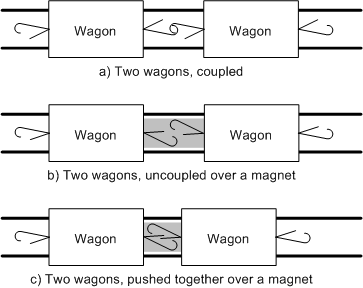
If the train is then pushed together while still over the magnet, the coupling does not mate. Instead it goes together in a way that allows the train to move but does NOT couple (picture c). This allows that coupling to be moved to a different part of the track without re-coupling. For a shunting operation this is useful: the train can be separated where the magnet is, then moved to where the rolling stock needs to be left.
The end result is a coupling that couples reliably, and uncouples reliably. It is less obtrusive than the "UK standard" coupler. Here's one installed to a UK carriage. You can see clearly the black "knuckle" coupler, and the gold coloured iron wire that operates it.
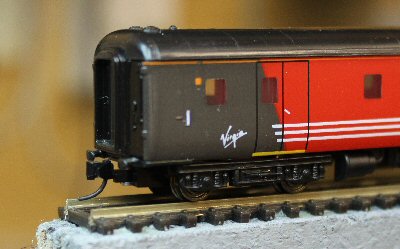
There are fundamentally two types of Micro-Trains couplings: body mounted, and truck mounted. The former mount to the body of the wagon / carriage / locomotive (as would happen on the real thing). The latter mount to the bogie, so as to allow operation on tight radius curves. There are different versions available in both types, distinguished by the length of the coupling rod (shank) from the model to the knuckle. In general, operation on small radius bends will require longer coupling "shanks". Diagrams showing the different variants are available.
These couplings are widely used on American models, with an extensive range of variants to cover different model types and coupling mountings. However none of them are explicitly designed for UK image rolling stock. Consequently some degree of modification will be involved. This means being brave!
The couplings are readily available in UK through specialist suppliers. Firstly, begin by getting the starter set (part number 1050). It includes so many useful bits and pieces that its cost will be more than repaid after installing a few couplers.
Micro-trains supply an extensive range of conversions to add couplings to N gauge rolling stock. Sadly none are specific to UK models. Luckily, they are sufficiently similar that the same conversion kits can be used. The no. 1129 kit converts a Rapido coupler pocket with a "medium" length shank coupler. This seems to be OK for the bogie oil tankers and reduces the coupled distance slightly (to 8.3mm buffer to buffer).
|
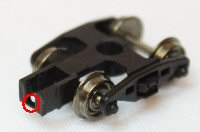 |
|
 |
|
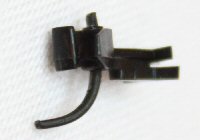 |
|
 |
|
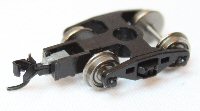 |
|
 |
|
|
|
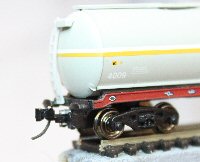 |
